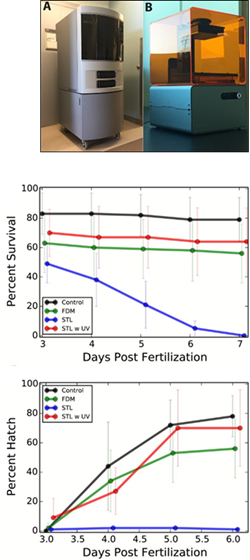A Method to Reduce the Toxicity of 3D-Printed Parts
Images

Top image: A is 3D FDM printer. B is a 3D STL printer. The middle graph shows the survival rates of exposed zebrafish embryos when compared to control unexposed embryos. The bottom graph shows the hatching rates of exposed zebrafish embryos when compared to control unexposed embryos.The zebrafish embryos are exposed to 3D-printed parts from a FDM and a STL printer. The STL printed parts when exposed to UV are less toxic when compared to the STL printed parts without UV treatment.
Background
3D printing (3DP), or additive manufacturing, is the process of digitally fabricating products layer by layer using a 3D printer and a computer-generated blueprint. 3DP can be used in various industries including but not limited to aerospace, healthcare, consumer, automotive, and energy sectors. ATKearney consulting firm called 3DP a manufacturing revolution, and McKinsey Global Institute chose it as one of the twelve top economically disruptive technologies. The total economic impact of 3DP will reach to the level of $230-550 billion per year by 2025, and the global market for 3D printing is forecasted to be $17 billion in 2020. Despite the rapid growth of 3DP industry and widespread acceptance of 3D-printed products among consumers, little has so far been done on assessing the toxicity of those products.
Brief Description
Prof. Will Grover from the University of California, Riverside has found that exposing 3D printed parts to UV light greatly reduces the toxicity of these parts. UCR scientists first revealed the dangerous effects of 3D printed parts on zebrafish embryos and then developed an easy-to-implement, industry-friendly protocol for the detoxification of 3D-printed products using UV light.
Advantages
- Decrease toxicity
- Maintain integrity and appearance
- Simple, accessible, cheaper
Applications
- 3D printers
- Automotive industry (specialized components, prototypes)
- Healthcare & life sciences industry (implants, stents, prosthetics)
- Consumer industry (apparel, fashion accessories)
Patent Status
| Country | Type | Number | Dated | Case |
| United States Of America | Issued Patent | 10,201,964 | 02/12/2019 | 2015-447 |
Contact
- Grace Yee
- grace.yee@ucr.edu
- tel: View Phone Number.
Other Information
Keywords
3-D printing, stereolithography, fused deposition modeling, SLA, STM, FDM, UV curing, reducing toxicity, 3-D printed parts, additive manufacturing
